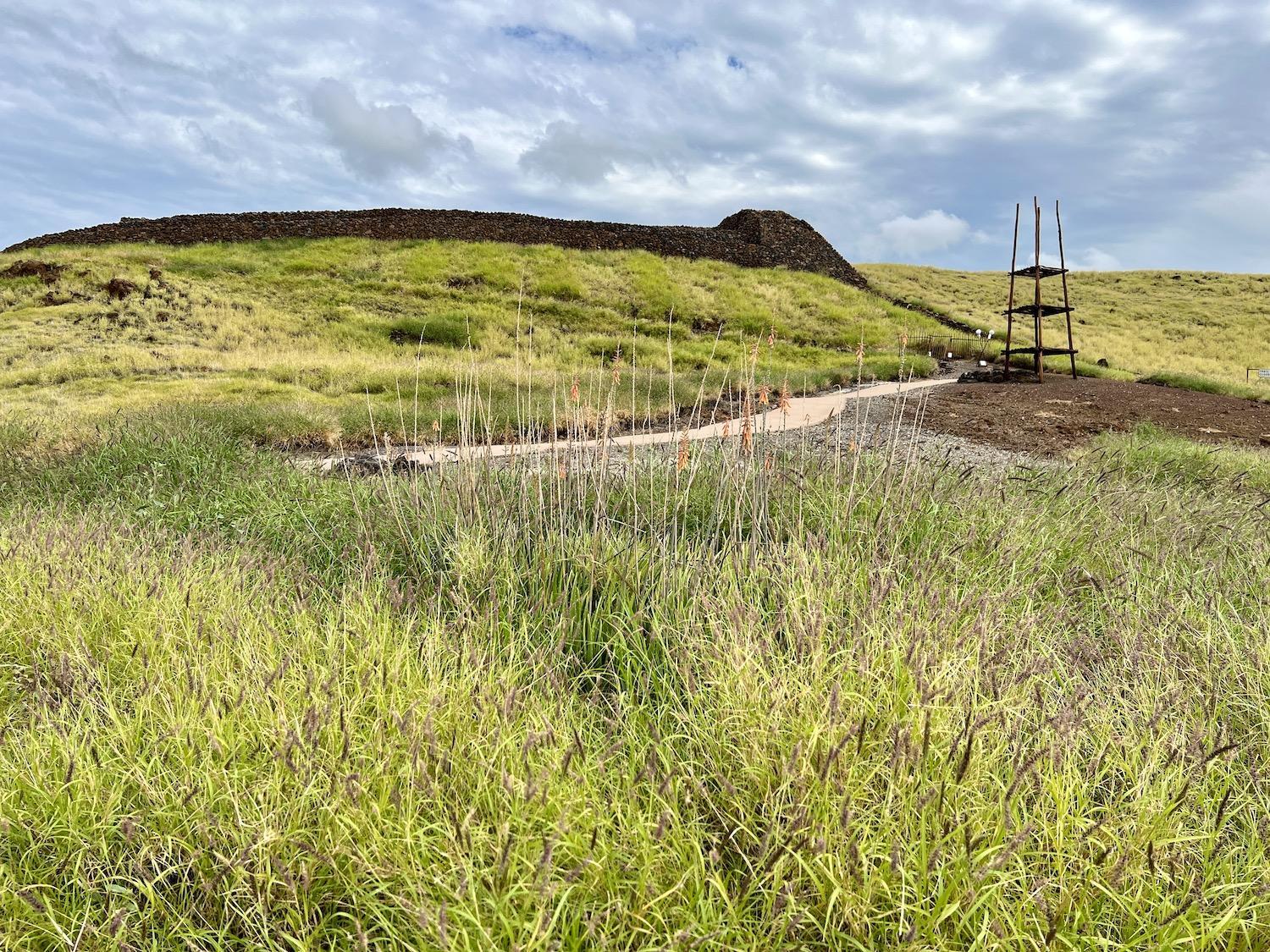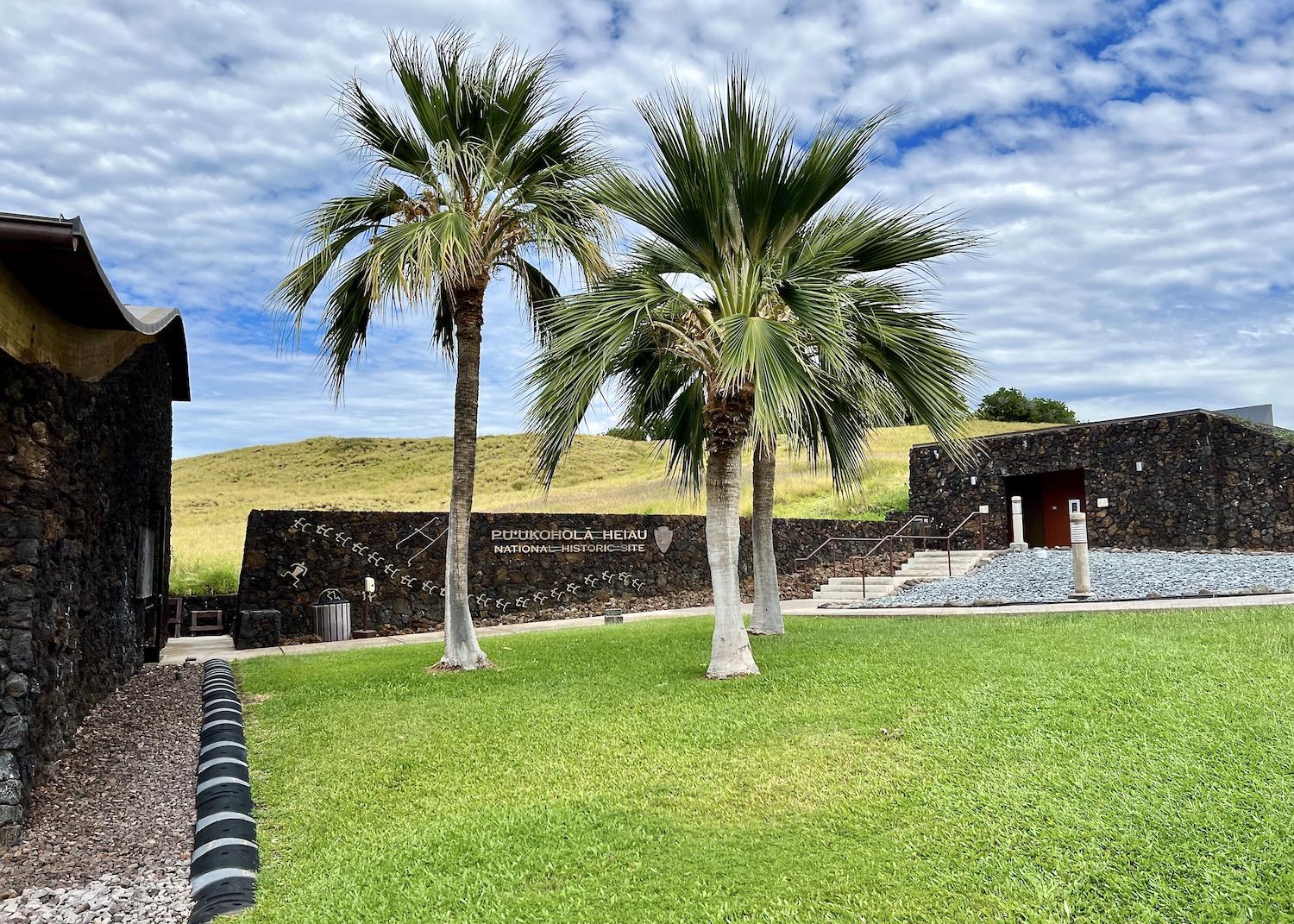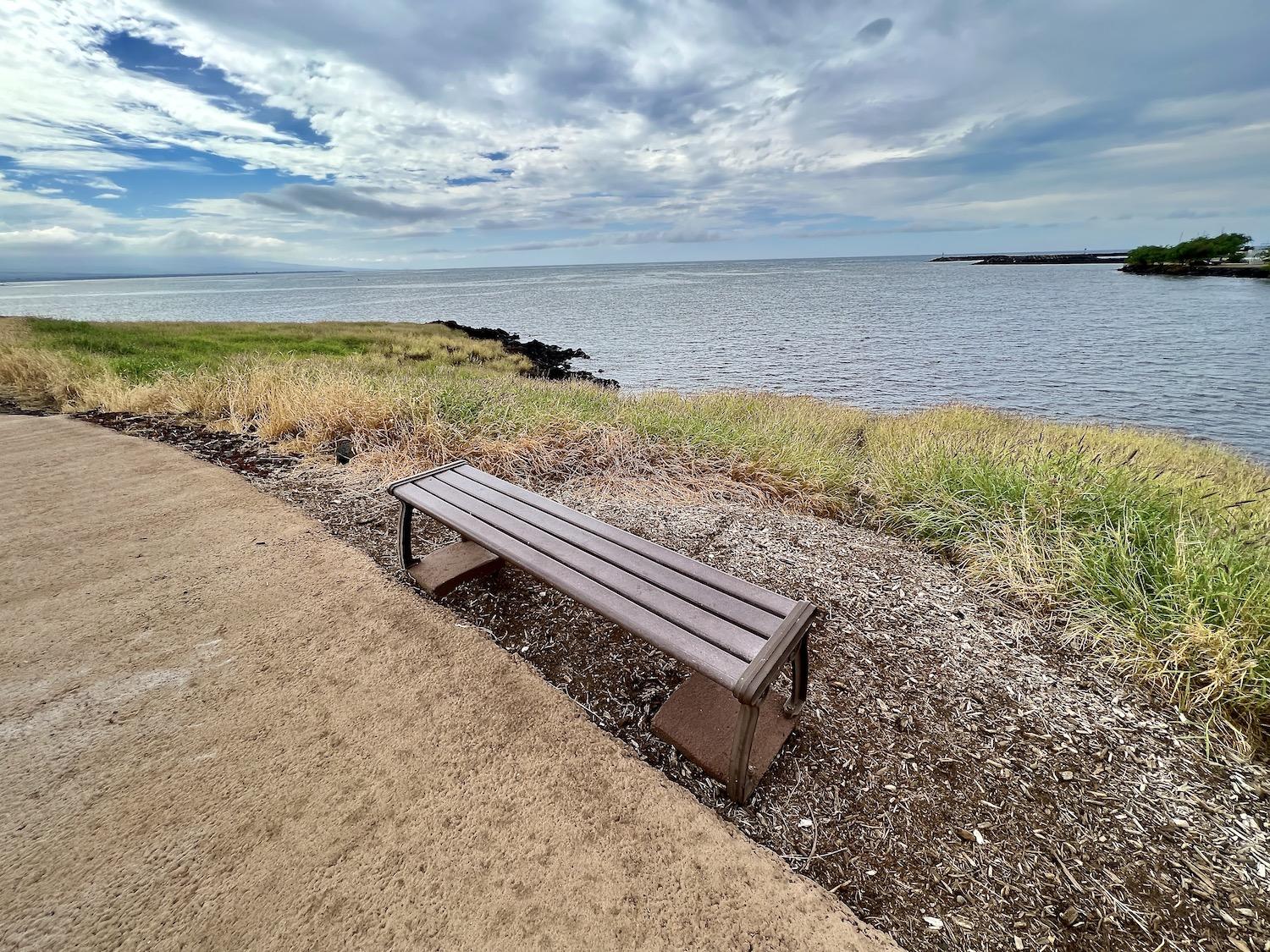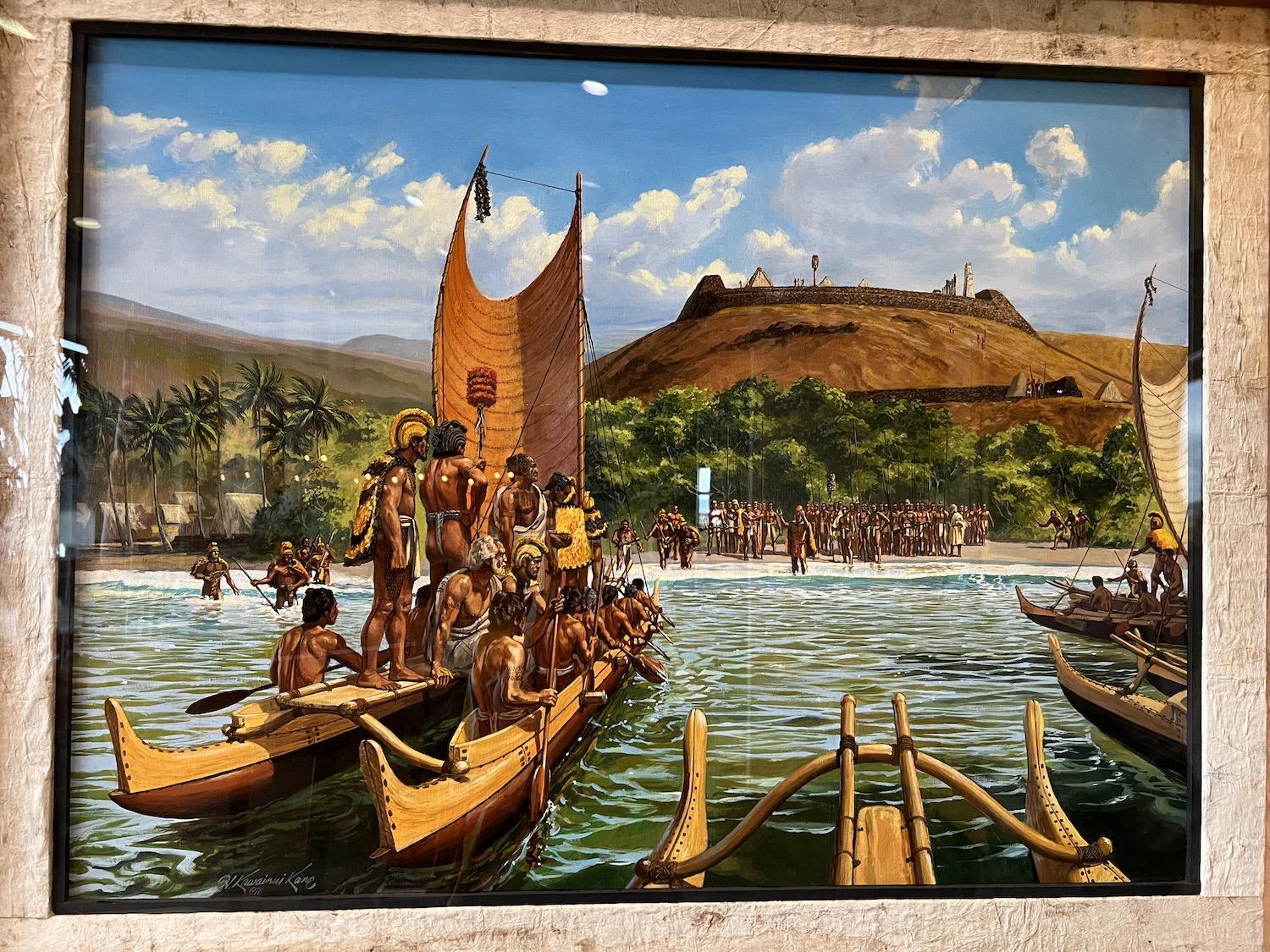
Pu'ukoholā Heiau National Historic Site protects this Pu'ukoholā Heiau (Temple on the Hill of the Whale)/Jennifer Bain
Much is left up to the imagination when you watch koholā (humpback whales) from shore on Hawaiʻi Island. You will see plenty of blows in the distance, as well as tail and pectoral flipper slaps. You may luck into spyhopping or a dramatic breach — but you need binoculars or a spotting scope to really see what’s going on. Mostly, you have to be patient and fill in the visual blanks.
On the day that I visited Puʻukoholā Heiau National Historic Site, it was whale-watching season and the endangered humpbacks had arrived from Alaska to mate, give birth and raise their young in the warm, shallow waters.
It was also a Tuesday morning in January so volunteers with the Hawaiian Islands Humpback Whale National Marine Sanctuary had set up outside the visitor center to chat, loan binoculars and share literature about responsible whale watching and threats to humpbacks (things like habitat degradation, collisions with boats and entanglement in marine debris).
“Look how far we can see from here for views of whales out in the ocean,” enthused volunteer Amalia Mueller before her husband John led an educational talk in the open-air amphitheater. “We help spot for people and help point out where the whales are. Oh, there’s another blow. And way out there, we had a breach and now a blow.”

Park visitors can borrow binoculars from Hawaiian Islands Humpback Whale National Marine Sanctuary volunteers during whale-watching season on Tuesdays from January to March/Jennifer Bain
The struggle to see whales with just the naked eye seemed an appropriate metaphor for the challenge that Puʻukoholā Heiau has conveying that this is one of the last major heiau (temples) built in the Hawaiian Islands and the site of a pivotal historical event.
Some 133,000 visitors came here in 2019 before the pandemic — a number that rebounded to 24,326 in 2021. Many have heard this is the best spot on the island to see whales. But Puʻukoholā Heiau — “the Temple on the Hill of the Whale” — is so much more than a land-based whale-watching site.
“It is the most historic site in all of Hawaiʻi,” park ranger George Enuton told me. “Historical means something that happened over a long period of time and had a very small change, if any, on history. We’re historic. It means something happened that was over a short period of time and that had a very big change on history. The biggest change on history in Hawaiʻi is unifying the Hawaiian Islands, ending five centuries of warring chiefdoms and bringing peace through unification. So this is literally the temple of unification.”

You can almost see the heiau (temple) on the hill behind the visitor center (left) and washrooms (right) at Puʻukoholā Heiau National Historic Site/Jennifer Bain
Puʻukoholā Heiau was built by King Kamehameha I and thousands of workers passing lava rocks by hand in a human chain. It was part of a prophecy. Kamehameha was advised by his kahuna (priest) that if he built and dedicated this heiau to the war god Kūkāʻilimoku at this specific place, he would unite the warring Hawaiian Islands into one royal kingdom. The heiau was started in 1790 and completed in 1791, and involved the sacrifice of the king’s rival and cousin Keōua Kūahu’ula. It took until 1810, but Kamehameha indeed became the first chief to unify all the islands.
The National Park Service took charge of the 85-acre site in 1972, but had to contend with the repercussions of years of free access inside the heiau that caused collapsed walls, vandalism and illegal camping and campfires. It closed the stone temple to the public for safety and sacred reasons. Only Native Hawaiians exercising traditional religious practices may enter.
Admittedly, these restrictions make it harder for visitors to connect with the story. The temple is on the brow of a hill and you can't get a real sense of the scope of this stone platform when you only view it from below. I set out on the half-mile, ADA-accessible trail from the visitor center to the heiau. Once there, I could only read a few interpretive signs and admire the temple’s outer walls and the traditional offering tower added by the park.

The short path from the visitor center to the heiau (temple) is ADA-accessible/Jennifer Bain
But I took my time and dug deeper. When Enuton turned me on to the free, 27-minute park audio tour in the NPS app, I walked the grounds a second time listening to it. Walking in the footsteps of warriors and builders, I learned that George Washington was the American president when Pu’ukoholā Heiau was being built.
I learned that heiau were places of worship and central to Hawaiian religious beliefs. From the heiau, the kahuna communicated with the gods and advised the ali’i (chief). They ranged from simple stone markers to massive stone platforms that might be topped with structures and wooden carvings.
This heiau — 224 by 100 feet with walls of up to 20 feet in places — could only be accessed by the priests and chiefly classes. It was built on top of another heiau. There were once wood-framed, thatched structures built on its platform, a wooden fence enclosing the front of the platform, and large wooden kiʻi (carved images) lining the perimeter and altar area. The skulls of human offerings were reportedly once displayed at the top of the fence.
“What might appear to some as nothing more than rocks on a dry and desolate hill, in reality stands as a silent testament to one of the greatest periods in Hawaiian history,” the NPS says on the park's website.

This is as close as you can get to the Puʻukoholā Heiau (temple)/Jennifer Bain
Puʻukoholā Heiau has three heiau. Pu’ukoholā is the most prominent but just below it is Mailekini Heiau, which is several hundred years older and was possibly a war or agricultural temple. Submerged just offshore is Hale o Kapuni, the ruins of what it believed to have been a temple tied to the shark gods.
Even though it’s now impossible to see Hale o Kapuni, visitors do come to see sharks. The accessible portion of the trail ends at the main heiau and from there the path slopes down hill and veers off to an overlook and the relocated remains of a stone leaning post. It’s said that a chief leaned against this post as he watched sharks circle Hale o Kapuni before they devoured the offerings he had placed there.
From the overlook, I took stairs down to the shore of Kawaihae Bay to a lush but quiet area called Pelekane, the Royal Courtyard, that comes alive every August with a Hawaiian cultural festival.

Sharks have long frequented the waters by Pelekane (Royal Courtyard) so it's not safe to swim or even wade/Jennifer Bain
Kawaihae Bay was one of the best landing spots on the west coast, once drawing Hawaiians in canoes and European whaling and trading vessels. The beach seems idyllic but visitors are warned not to swim or even wade here because sharks — known as manō and believed to be ancestral deities — have gravitated to this bay for centuries.
I saw dark triangles moving in the water, but without binoculars can’t say for certain whether they were the dorsal fins of black-tipped reef sharks, rocks being exposed as the tide went out, or just my imagination.
From the beach, the path heads back up more stairs and becomes Ala Kahakai National Historic Trail. It follows the coast for a short jag before butting up against Spencer Beach Park and looping back to the visitor center.

There's a scenic bench along the coastal Ala Kahakai National Historic Trail in the park where you can watch for humpback whales, dolphins and sharks/Jennifer Bain
Don't rush this sacred site. I spent an hour in the amphitheater watching two videos, and more time poring over exhibits and displays and then browsing in the non-profit store. There’s a traditional koa wood spear display, three original paintings by the late Herb Kawainui Kāne, and a popular rock-lifting display.
According to the prophecy, Enuton explained, he who overturned the 5,000-pound Naha Stone possessed the mana (spiritual power) to rule the land. King Kamehameha overturned the stone. It was a test of spiritual, not physical, strength.

Park ranger George Enuton stands by a rock strength display at the visitor center that speaks to the story of King Kamehameha and the Naha Stone/Jennifer Bain
When visitors argue with Enuton about how it’s not possible to lift a 5,000-pound stone, he asks them if they believe Moses parted the Red Sea and, if so, why. In other words, “It might not be your belief or spirituality, but it’s somebody else’s belief and just because you don’t believe it, doesn’t mean it’s crazy.”
The ranger is mindful that visitors have different levels of interest, and different levels of how much they can handle hearing, seeing and reading. For the average person, his focus is on sharing the unification story. For those who want the richer, deeper story, he stands ready with details. He uses an analogy about coloring books. History is dates, events, facts, figures and numbers — the white page with the black lines in a coloring book. But by also sharing the culture, you add "the color to the coloring book."
"I connect the culture to the history. Then it becomes a beautiful picture and you understand it a lot more."

One of three paintings the NPS commissioned from Herb Kawainui Kāne, "A Ceremony at Puʻukoholā Heiau" depicts the pivotal event in the history of the Hawaiian Islands when King Kamehameha finished building his temple and greeted his rival and cousin in the bay/Jennifer Bain
Enuton has worked here for 15 years. He reminded me that the NPS oversees 424 individual units, yet only a fraction of those are well-known "NPs" (national parks) like Yosemite, Grand Canyon and Hawai'i Volcanoes National Park (where I volunteered to remove invasive Himalyan ginger).
“Some people will say `Oh yeah there are 67 NPs and the rest are just others.' And it’s like `No they are all important because parks have different things they focus on,'" he said. "There are a lot of parks that don’t focus on nature but they focus on the very big historical events in America. A lot of people, when they come to places like this, they go 'You know what? I never knew that, but this is actually really cool that parks focus on things besides a plant or a tree or a canyon or a volcano.'”
Truth be told, there's plenty of nature here at Puʻukoholā Heiau beyond the marine life. I learned from that audio tour that a lack of rainfall creates unusual, desert-like conditions. Birders might spot the Black-crowned Night-Heron, Saffron Finch, Japanese White-eye, Common Myna, Grey Francolin or Yellow-billed Cardinal. Mongoose, wild goats and wild pigs are regulars, though of course they're invasive species and not to be celebrated. Some lucky folks get to see the Hawaiian hoary bat or the Hawaiian blind snake.
It's hard to believe all this exists on just 85 acres, but this site was singled out long ago as some place special.
While You’re In The Area:

Outside Hilo Public Library, you can see the Naha Stone (left) that King Kamehameha I once lifted on his path to fulfilling a prophecy to unite the Hawaiian Islands/Jennifer Bain
Visit: The Naha Stone now rests in front of the Hawaii Public Library in Hilo. According to a plaque, it was brought by canoe from the "chiefly valley of Wailua" on Kaua'i centuries ago. It had a place of honor at heiau in Hilo and was said to have been associated with traditions of affirming chiefly status. King Kamehameha was said to have lifted this stone as a young warrior in 1789 when he was in his early 30s, thus confirming the prophecy that he would be a great warrior king. The upright Pinao Stone beside the Naha Stone was found at Pinao Heiau near the current state library. "These stones are important cultural resources," a sign reminds people. "Please refrain from sitting or standing on the stones and treat this area with respect."
Stay: I moved between four hotels over eight nights on Hawai'i Island. The Waikoloa Beach Marriott Resort & Spa is on the sunny Kohala Coast by the white sands of 'Anaeho'omalu Bay. More importantly, it’s a good base to explore three NPS sites. It’s just a 15-minute (10-mile) drive south of Pu'ukoholā Heiau. It’s also 30 minutes (22 miles) north of Kaloko-Honokōhau National Historical Park (where I learned about reef-safe sunscreen, sea turtles and historic fishponds), and an hour (48 miles) from Puʻuhonua o Hōnaunau National Historical Park.

Fishing at sunset in ʻAnaehoʻomalu Bay by the Waikoloa Beach Marriott Resort and Spa/Jennifer Bain

 Support Essential Coverage of Essential Places
Support Essential Coverage of Essential Places



